Win pergola
Wednesday, July 18th, 2012Win a pergola for your garden worth £259.99
With the guardian
Archive for July, 2012Win pergolaWednesday, July 18th, 2012Win a pergola for your garden worth £259.99 With the guardian Pre planted hanging basketsWednesday, July 18th, 2012Perfect for the lazy gardener – pre planted hanging baskets A lovely instant way of adding colour to the outside of your home.  2 Hanging Baskets Geranium Mixed Ivy Trailing £19.90 Save time and money with our pre-planted hanging basketsEach hanging basket contains 5 Geranium Mixed Ivy plants, compost, FREE Raingel and feed treatment. Care instructions are included.A proven performer, this collection of trailing geraniums will provide months of colour in your hanging baskets. The delicate flowers will cascade over the hanging baskets, which themselves measure 27cm and are re-usable.  2 Hanging Baskets Fuchsia Mixed Foliage Trailing £19.90 Save time and money with our pre-planted hanging basketsEach hanging basket contains a total of 5 Fuchsia and Mixed Foliage plants, compost, FREE Raingel and feed treatment . Care instructions included.A lovely combination of pink and white trailing Fuchsia and mixed foliage. The Fuchsia have brightly coloured pink tubular flowers that trails and so is perfect for tubs and baskets. It is sure to produce an eye catching display throughout the summer. The mixed foliage provides a perfect complement to the Fuchsia. The hanging baskets themselves measure 27cm and are re-usable.  2 Hanging Baskets Fuchsia Trailing £19.90 Save time and money with our pre-planted hanging basketsEach hanging basket contains 5 Fuchsia Trailing plants, compost, FREE Raingel and feed treatment. Care instructions included.This Fuchsia has brightly coloured pink tubular flowers that trails and so is perfect for tubs and baskets. It is sure to produce an eye catching display throughout the summer. Good all weather tolerance.  2 Hanging Baskets Petunia Surfina Classic Trailing £19.90 Save time and money with our pre-planted hanging basketsEach hanging basket contains 5 Petunia Surfina Classic Trailing plants, compost, FREE Raingel and feed treatment . Care instructions are included.Petunias have colourful flowers that cascade beautifully over the sides of each hanging basket. The hanging baskets themselves measure 27cm and are re-usable.  2 Hanging Baskets Petunia Tumbelina Scented Trailing £19.90 Save time and money with our pre-planted hanging basketsEach hanging basket contains 5 Petunia Tumbelina Scented Trailing plants, compost, FREE Raingel and feed treatment. Care instructions are included.Petunias have colourful flowers that will bring masses of interest throughout the summer. This Petunia Tumbelina has masses of scented pink and lilac double flowers that will cascade beautifully over the sides of the hanging baskets. The hanging baskets themselves measure 27cm and are re-usable.  2 Hanging Baskets Petunia Million Bells Trailing £19.90 Save time and money with our pre-planted hanging basketsEach hanging basket contains 5 Petunia Million Bells Trailing plants, compost, FREE Raingel and feed treatment. Care instructions included.These Petunias have masses of pastel coloured trumpet shaped flowers that will cascade beautifully over the sides of the hanging baskets, which themselves measure 27cm and are re-usable.  2 Hanging Baskets Verbena Trailing £19.90 Save time and money with our pre-planted hanging basketsEach hanging basket contains 5 Verbena Trailing plants, compost, FREE Raingel and feed treatment . Care instructions are included.These Verbena have large flowers in a range of colours with a compact habit. They are resistant to mildew. The hanging baskets themselves measure 27cm and are re-usable. Best selling bedding plants from Jersey Plants DirectWednesday, July 18th, 2012Time to start thinking about ordering your autumn bedding plants. JPD offer free delivery on every order.  Mixed Autumn Bedding Collection 50 plants + 20 FREE £12.99 Looking for a mix of bedding plants in smaller quantities – this is the collection for you!Varieties are: Pansy Grande Fragrance: This beautifully scented plant has large flowers and is an excellent winter performer. Primrose Valiant: A fully frost hardy primrose. Pansy Cascadia (Trailing): A unique trailing variety that is ideal for hanging baskets and containers. Each variety will bloom at different times from autumn to spring/early summer.This collection of our best selling autumn bedding plants is perfect for smaller gardens where space is limited but you still want variety.  Pansy Grande Fragrance 50 Plants + 20 FREE £12.99 Beautifully scented Pansy with large flowersPansies are part of the Viola family. Pansy Grande fragrance is one of our favourite Pansies, available for sale in the Autumn and the Spring. The brightly coloured faces of these large flowers are also scented. Perfect for the front of your borders or in patio pots and containers and are an excellent winter performer.  Pansy Can Can 50 Plants + 20 FREE £12.99 The original and best ruffled pansyPansies are part of the Viola family. This beautiful ruffled pansy comes in a mix of pastel colours with dark centres. These pansies will flower from April through to October providing a fantastically long flowering period. Pansy Can Can is the original and best ruffled pansy.  Wallflower Fortune 50 Plants + 20 FREE £12.99 Scented and perfect filling those winter gaps This variety of wallflower is a F1 variety which is scented. Lovely long lasting displays from this reliable bedding plant.  Primrose Rosebud 50 Plants + 20 FREE £15.49 Early flowering and great for a house plantThese bedding plants produce flowers that are like clusters of miniature roses making it a lovely primrose for winter colour. They also make a great houseplant  Primrose Valiant 100 Plants + 60 FREE £15.49 Ideal for adding some colour in winterThis variety is a customer favourite, a fantastic primrose for winter colour. These bedding plants are fully frost hardy and specifically bred for winter performance. Borage for beesWednesday, July 18th, 2012Another brilliant plant for bees! 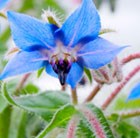 borage (borage – organic) £1.99 Position: full sun or light shade Soil: fertile and moist Rate of growth: fast Hardiness: hardy annual (it will die within one year) A wonderfully useful as well as decorative plant. The young leaves and vivid blue flowers of this annual herb have a fresh cucumber-like flavour, so are often used in salads, soups, chilled drinks or simply as a garnish. The flowers attract bees and other beneficial insects, while the foliage has been known to reduce attacks of hornworm when planted between tomato plants. At the end of the year, add the plants to the compost heap as they will promote many beneficial minerals. Borage is an annual plant, but it will self-seed readily in good conditions. If you don’t want more plants, dead-head the flowers as soon as they fade. Garden care: Form shallow drills at 30cm intervals in a well prepared bed, and sow thinly, just covering the seed before watering well. The seeds have a higher germination rate when temperatures are between 15 – 25C, so early sowings can be covered with a cloche. When big enough to handle, thin the seedlings to 25cm. Sow: March – May Flowering: June – September Approximate quantity: 75 seeds. 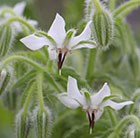 white borage (white borage) £1.99 Position: full sun or light shade Soil: fertile and moist Rate of growth: fast Hardiness: fully hardy The white flowers of this borage make a fresh change to the more traditional blue. The bees will still flock to the nectar-rich blooms, and if picked, the petals can be used to decorate ice bowls and dress soups and salads. The young leaves of this annual have a cucumber-like flavour and can be added to many recipes. They are often used in pasta dishes, while the flowers can be used in ice cubes, salads and even dipped in batter and deep fried. Plant them between your tomatoes to reduce attacks of hornworm. At the end of the year, add the plants to the compost heap as they will promote many beneficial minerals. Borage is an annual plant, but it will self-seed readily in good conditions. If you don’t want more plants, dead-head the flowers as soon as they fade. Garden care: Form shallow drills at 30cm intervals in a well prepared bed, and sow thinly, just covering the seed before watering well. The seeds have a higher germination rate when temperatures are between 15 – 25C, so early sowings can be covered with a cloche. When big enough to handle, thin the seedlings to 25cm. Sow: March – May Flowering: June – September Approximate quantity: 75 seeds. Hyssop for beesWednesday, July 18th, 2012 Agastache ‘Black Adder’ (hyssop) £7.99 Position: full sun Soil: well-drained, fertile soil Rate of growth: average Flowering period: July to October Hardiness: hardy (borderline) Hyssops are great for adding height to a border, with whorls of long-lasting, tiny flowers arranged like a bottlebrush and pointed, aromatic fresh green leaves that are attractive to butterflies. They are short-lived though, and may need replacing every few years, especially after a cold or wet winter. ‘Black Adder’ has smoky, violet flowers on long spires from July to October. Try it as part of a Mediterranean scheme or in a sunny, well-drained border among ornamental grasses. Garden care: Don’t cut back the faded flower-stems until early spring, as they provide interest in the winter months. Lift and divide congested colonies in spring.  Agastache ‘Painted Lady’ (giant hyssop) £7.99 Position: full sun Soil: well-drained, fertile soil Rate of growth: average Flowering period: July to October Flower colour: pinkish-orange Hardiness: half hardy Spikes of beautiful, tubular pinkish-orange flowers appear from July to October above the aromatic, grey-green leaves. This new upright, perennial is perfect for the middle of a sheltered, sunny border. An excellent companion for grey or silver foliage plants, the long-lasting flowers are highly attractive to bees. Garden care: Avoid the temptation to cut back the faded flower-stems in autumn since they provide interest in the winter months. Lift and divide congested colonies in spring.  Agastache ‘Black Adder’ (hyssop) £5.99 Position: full sun Soil: well-drained, fertile soil Rate of growth: average Flowering period: July to October Hardiness: hardy (borderline) Hyssops are great for adding height to a border, with whorls of long-lasting, tiny flowers arranged like a bottlebrush, and pointed, aromatic fresh green leaves that are attractive to butterflies. They are short-lived though, and may need replacing every few years, especially after a cold or wet winter. ‘Black Adder’ has smoky, violet flowers on long spires from July to October. Try it as part of a Mediterranean scheme or in a sunny, well-drained border among ornamental grasses. Garden care: Don’t cut back the faded flower-stems until early spring, as they provide interest in the winter months. Lift and divide congested colonies in spring. 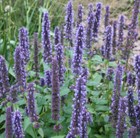 Agastache ‘Blue Fortune’ (Mexican giant hyssop) £4.99 Position: full sun Soil: well-drained, fertile soil Rate of growth: average Flowering period: July to October Hardiness: hardy (borderline) Hyssops are great for adding vertical accents to a border, with whorls of long-lasting, tiny flowers arranged like a bottlebrush and pointed, aromatic fresh green leaves that are attractive to butterflies and bees. They are short-lived though, and may need replacing every few years, especially after a cold or wet winter. Blue Fortune has loose spires of lilac-blue flowers from July to October and peppermint-scented leaves. This upright, bushy perennial is perfect for the middle of a sheltered, sunny border. Try it as part of a Mediterranean scheme, with grey-leaved plants, or among ornamental grasses. Garden care: Don’t cut back the faded flower-stems in until early spring, as they provide interest in the winter months. Lift and divide congested colonies in spring. Marjoram for the beesWednesday, July 18th, 2012They’ll love this! It’s on the RHS list of plants for bees. 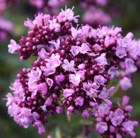 Origanum laevigatum ‘Herrenhausen’ (marjoram) £6.99 Position: full sun Soil: poor to moderately fertile, well-drained, preferably alkaline soil Rate of growth: average Flowering period: June to September Hardiness: fully hardy Small, round, purple-flushed, inedible leaves are topped, from June to September, by dense clusters of tiny pink flowers borne on red-purple stems. As it matures, the foliage turns dark green. Marjoram is a long- flowering perennial that makes a colourful edging plant for a sunny, well- drained border or herb garden. It thrives on alkaline soil, an important consideration when planting a site recently cleared of builders’ rubble. Garden care: Cut back old faded flower-heads and stems in spring. 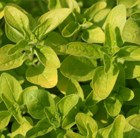 Origanum vulgare ‘Aureum’ (golden wild marjoram) £6.99 Position: full sun or partial shade Soil: poor to moderately fertile, well-drained, preferably alkaline soil Rate of growth: slow to average Flowering period: June to September Hardiness: fully hardy Loose clusters of pale pink flowers appear from mid summer to early autumn among aromatic golden leaves that mature to a deeper green. This golden, wild marjoram makes a pretty edging plant for a sunny herb or gravel garden, where the leaves can be used to make savoury sauces. It thrives on alkaline soil, an important consideration when planting a site recently cleared of builders’ rubble. Garden care: Ensure that plants are well watered during the growing season. Cut back established plants by a two-thirds in late summer to prevent them from becoming too straggly. Green manures at CrocusWednesday, July 18th, 2012Use a green manure to cover ground you don’t want to plant anything in at the moment. Short term plantings that can be dug into the soil after to emable you to keep soil covered with vegetation which helps reduce weed ingress. Also provides nutrients to the soil when dug in to rot. 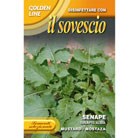 mustard (green manure) £2.99 Position: full sun Soil: humus-rich, moisture retentive soil Rate of growth: fast Hardiness: tender Mustard as a green manure is particularly useful in the fight against roundworm. It also fixes nitrogen in the soil and adds organic matter to helps get your plants off to a great start. 100g of seed will cover approximately 70m2. Once the plant has grown, cut back when it starts flowering (about 40-50 days after germination) and after a couple of days dig in to 20cm depth with a hoe. The ground is then prepared for seeding your flowers and vegetables. Growing Instructions Sow outside – March to October  Limnanthes douglasii (poached egg) £2.49 Position: full sun Soil: moist, well-drained soil Rate of growth: average Flowering period: June to September Flower colour: yellow Other features: the flowers are highly attractive to bees and hoverflies Hardiness: hardy annual A profusion of fragrant, yellow-centred white flowers appear throughout the summer above the fleshy, fern-like, bright yellow-green leaves. This pretty, poached-egg plant makes a fabulous informal edge for a sunny, well-drained border. Highly attractive to beneficial insects including bees and hoverflies, it will help reduce pest colonies in the vegetable garden. An easy to grow annual, it is ideal for the children’s garden and will self-see freely. It will also make a wonderful green manure crop. Garden care: Early sowings can be started under glass into good seed compost, which should be kept moist but not wet. Gradually harden off before planting outside. After the frosts, they can be sown shallowly, directly into well-prepared, sunny beds outside. When the seedlings are large enough to handle thin to 10cm. Sow: February – May or August – September Flowering: June – September Approximate quantity: 30 seeds. 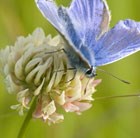 Trifolium repens (white clover – green manure) £2.49 Position: full sun or partial shade Soil: fertile, moist, well-drained soil Rate of growth: fast Flowering period: April to September Flower colour: white, sometimes flushed with red Hardiness: fully hardy A common sight in wild meadows, this fast-growing clover has rich green leaflets, often with a creamy white band at their base. For many months from spring to autumn, clusters of near-white flowers appear in profusion and these are very attractive to bees and other pollinating insects. This is one to avoid if you want a pristine lawn (it can become invasive), but it is perfect if you want to create low-growing ground cover in record time. White clover can also be grown as a green manure crop and dug into the soil before the plants start to flower. Garden care: Sow shallowly in pots or trays at any time of the year using good seed compost and keep moist but not wet. Place them in a warm position with a little light shade until they have germinated, then move them into the sun. If necessary thin them out and plant them out after they have grown on. Sow: January – December Flowering: April-September Approximate quantity: 750 seeds  Phacelia tanacetifolia (fiddleneck) £1.79 Position: full sun Soil: any, fertile, well-drained soil Rate of growth: average to fast-growing Flowering period: June to September Flower colour: lavender-blue Other features: contact with the foliage may aggravate skin allergies Hardiness: hardy annual Lavender-blue, bell-shaped flowers, which are laden with nectar, form in densely-packed clusters on sturdy stems and attract bees and other beneficial insects in their droves. Perfect for wildflower meadows, or naturalised planting schemes, the flowers will last well after being cut. The fast growing foliage will help suppress weeds and makes an attractive groundcover. Scorpion weed can also be treated as a green manure crop, which will help enrich the soil. They self-seed freely. Garden care: From early spring, sow into small pots filled with good seed compost and initially protect with a cold frame or unheated greenhouse. Pinch out the growing tips to encourage bushier growth and harden off before planting out. Alternatively sow direct in autumn into a sunny, well-prepared seed bed. Easy to grow, if you do not want the plants to set seed, remove the spent flowers as they fade. Sow: March-May or September-October Flowering: June-September Approximate quantity: 25 seeds. Sage for the beesWednesday, July 18th, 2012Another brilliant herb for the garden.  Salvia x sylvestris ‘Rose Queen’ (sage) £7.99 Position: full sun or partial shade Soil: light, moderately fertile, humus-rich, moist but well- drained soil Rate of growth: average Flowering period: June and July Flower colour: bright rose-pink Other features: attractive to butterflies and bees; wrinkled, grey-green leaves Hardiness: fully hardy Slender spires of bright rose-pink flowers, which open from dark pink buds from early to midsummer, look lovely and attract butterflies and bees to the garden. ‘Rose Queen’ is perfect for filling gaps left by spring-flowering plants in the middle of a moist, well-drained herbaceous border. Garden care: To prolong flowering remove the flower spikes as soon they start to fade. Apply a generous 5-7cm (2-3in) mulch of well-rotted garden compost or manure around the base of the plant in spring. 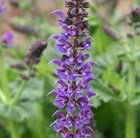 Salvia x sylvestris ‘Mainacht’ (sage (syn. Salvia May Night)) £5.99 Position: full sun or partial shade Soil: light, moderately fertile, humus-rich, moist but well- drained soil Rate of growth: average Flowering period: June and July Flower colour: indigo-blue Other features: attractive to butterflies and bees; wrinkled, grey-green leaves Hardiness: fully hardy A delightful, colourful plant with spikes of indigo-blue flowers in early to midsummer. This reliable perennial is ideal for the middle of a moist, well-drained herbaceous border. It flourishes in sun or dappled shade where the bright flowers help to liven up any plant scheme. Garden care: To prolong flowering remove the flower spikes as soon they start to fade. Apply a generous 5-7cm (2-3in) mulch of well-rotted garden compost or manure around the base of the plant in spring.  Salvia uliginosa ‘African Skies’ (bog sage) £4.99 Position: full sun Soil: moderately fertile, moist soil Rate of growth: average Flowering period: July to September Flower colour: sky blue Other features: aromatic foliage Hardiness: frost hardy (needs winter protection) Slender branching stems are clothed in aromatic green leaves. From midsummer, these tall stems are then topped with elegant racemes of sky blue flowers, which attract bees, butterflies and other beneficial insects into the garden. Forming quite large-sized clumps, it thrives in a sunny spot with reliably moist soils. Garden care: To prolong flowering remove the flower spikes as soon they start to fade. Apply a generous 5-7cm (2-3in) mulch of well-rotted garden compost or manure around the base of the plant in spring. 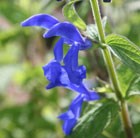 Salvia patens (sage) £7.99 Position: full light (with shade from hot sun) Soil: well-drained Rate of growth: average Flowering period: July to September Flower colour: blue Hardiness: frost hardy (needs winter protection) Superb vigorous variety of ornamental sage with slender spires of large blue flowers from midsummer to autumn. A perfect plant for a cool planting scheme or for adding to a mixed border where it will add vibrancy. Garden care: To prolong flowering remove the flower spikes as soon they start to fade. Apply a generous 5-7cm (2-3in) mulch of well-rotted garden compost or manure around the base of the plant in spring.  Salvia officinalis (common sage) £6.99 Position: full sun or partial shade Soil: light, fertile, moist, well-drained soil Rate of growth: average to fast Flowering period: May to July Flower colour: lilac-blue Other features: the leaves can be used fresh or dried to make stuffings, herb teas and herb butter Hardiness: fully hardy Spikes of lilac-blue flowers in early to mid-summer and grey-green aromatic leaves. Sage’s handsome foliage makes a fabulous and robust edge for a sunny herb garden or mini potager. Collected before the plant has flowered and freshly chopped, the aromatic leaves are valuable for flavouring stuffings, herbal teas and meat dishes. Garden care: To encourage a plentiful supply of young foliage gather the leaves regularly and prune lightly in July after flowering.  Salvia officinalis ‘Purpurascens’ (Purple Sage) £4.99 Position: full sun or partial shade Soil: light, fertile, moist, well-drained soil Rate of growth: average to fast Flowering period: May to July Flower colour: lilac-blue Other features: the leaves can be used fresh or dried to make stuffings, herb teas and herb butter Hardiness: fully hardy An attractive, upright perennial with aromatic, grey green foliage, which is initially flushed with a reddish-purple as it emerges. From early summer the branching stems are topped with spires of lilac-blue, two-lipped flowers, which are particularly loved by bees. A valuable addition to the herb garden, the leaves are high in vitamins A and C and can be used to make stuffings, as well as enhance the flavour of many meat and fish dishes. Garden care: To encourage a plentiful supply of young red- purple foliage gather the leaves regularly and prune lightly in July after flowering. 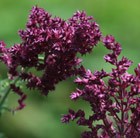 Salvia nemorosa ‘Schwellenburg’ (meadow sage) £15.99 Position: full sun Soil: light, moderately fertile, humus-rich, moist but well- drained soil Rate of growth: average Flowering period: July to September Flower colour: pinky-purple Other features: attractive to butterflies and bees Hardiness: fully hardy Dense and upright in habit, the grey-green foliage contrasts perfectly with the rose-tinted, purple flowers. This plant has a long flowering period providing it gets plenty of sun and you remove the spent flowers as they fade. It tends to flower a little later than most other salvias, so its a good one to choose of you are looking to prolong the summer colour. Garden care: To prolong flowering remove the flower spikes as soon they start to fade. Cut back all the stems after they have finished flowering and apply a generous 5-7cm (2-3in) mulch of well-rotted garden compost or manure around the base of the plant in spring. 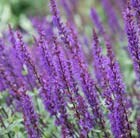 Salvia nemorosa ‘Caradonna’ (sage) £5.99 Position: full sun Soil: light, moderately fertile, humus-rich, moist but well- drained soil Rate of growth: average Flowering period: June to October Flower colour: violet-blue Other features: attractive to butterflies and bees Hardiness: fully hardy A superb cultivar with glowing purple stems loaded with violet-blue flowers from June to October. The grey-green, aromatic foliage also makes an attractive accent in the summer border. A compact variety that is perfect for adding a splash of colour at the front of a well- drained herbaceous border or gravel garden. It thrives in a sunny spot and will become drought tolerant once established. The blooms are a magnet for butterflies and bees. Garden care: To prolong flowering remove the flower spikes as soon they start to fade. Apply a generous 5-7cm (2-3in) mulch of well-rotted garden compost or manure around the base of the plant in spring. 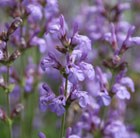 Salvia lavandulifolia (Spanish sage) £7.99 Position: full sun Soil: moderately fertile, humus-rich, well- drained soil Rate of growth: average Flowering period: July to September Hardiness: fully hardy Originating from rocky and stony places in the mountains of Spain, this sun loving, drought tolerant plant is quite a tough customer. Its leaves are edible and in Spain, it is the only sage used. It has smaller leaves and a stronger flavor and smell than our common sage. The flowers are glorious too and appear in mid to late summer. It needs a sunny spot, but looks great in a mixed, informal border, potted up with a selection of other herbs, or even gracing a dry stone wall. Garden care: To prolong flowering remove the flower spikes as soon they start to fade. Apply a generous 5-7cm (2-3in) mulch of well-rotted garden compost or manure around the base of the plant in spring.  Salvia guaranitica ‘Black and Blue’ (sage) £9.99 Position: full sun Soil: moderately fertile, moist but well-drained soil Rate of growth: average Flowering period: August to October Flower colour: dark purple-blue Other features: softly hairy foliage Hardiness: half hardy (will need protection during winter) The flower colour of this glorious perennial is quite simply breath-taking, and this coupled with the plants strong architectural presence, will ensure that heads will be turned towards the back of the border. From late summer to late autumn, 30cm long upright spikes carry sumptuously coloured purple-blue flowers, which are held at their bases by near-black calyces – hence the name ‘Black and Blue’. This is a vigorous plant, but it is not fully hardy, so it will need some protection in winter. Therefore, it is ideally suited to grow near a sheltered, south facing wall. Garden care: To prolong flowering remove the flower spikes as soon they start to fade. Apply a generous 5-7cm (2-3in) mulch of well-rotted garden compost or manure around the base of the plant in autumn to help keep the roots warm.  Salvia argentea (sage) £9.99 Position: full sun or partial shade Soil: light, moderately fertile, moist but well-drained Flowering period: July to August Other features: silver-wooly folaige Hardiness: fully hardy Primarily grown for its softly-hairy, silvery foliage, which forms impressive clumps, in its second year, it will also produce an upright branching flowerspike, bearing white to pink-flushed flowers. Magestic plants which are are mainly bi-ennial, or short-lived perennials, although they usually self-seed freely in good conditions. A classic for gravel or Mediterranean-style gardens. Garden care: Protect from excessive winter wet. To prolong flowering remove the flower spikes as soon they start to fade. Apply a generous 5-7cm (2-3in) mulch of well-rotted garden compost or manure around the base of the plant in spring. Thymes for beesWednesday, July 18th, 2012Reasons to grow thyme in your garden: 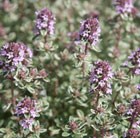 Thymus vulgaris ‘Silver Posie’ (thyme) £5.99 Position: full sun Soil: well-drained neutral to alkaline soil Rate of growth: average to fast Flowering period: May and June Flower colour: bright purple to white Other features: the aromatic leaves are a useful ingredient in bouquet garni, stuffings and sauces; highly attractive to bees and other beneficial pollinating insects Hardiness: fully hardy Bright purple to white flowers in late spring and early summer and wonderful, white-margined, aromatic, grey-green leaves. This bushy, creeping thyme is an excellent ground cover plant. Perfect for a sunny rock garden or for edging paths and borders, the aromatic leaves are useful for making bouquet garni, stuffings and sauces. Garden care: After flowering cut back hard using garden shears to retain a neat compact shape. Lift and divide large clumps in early spring 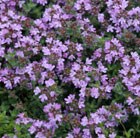 Thymus pseudolanuginosus (woolly thyme) £4.99 Position: full sun Soil: well-drained neutral to alkaline soil Rate of growth: average to fast Flowering period: June to July Flower colour: pale pink Other features: extremely low growing Hardiness: fully hardy Tiny, pale pink flowers appear in summer amongst small, grey, woolly foliage. This is one of the woolliest thymes available and as its low growing is ideal as an unusual ground cover. Unfortunately it’s not suitable for culinary use but the flowers are highly attractive to bees and other beneficial pollinating insects. Great for growing between paving or in cracks in stone walls. Garden care: Susceptible to root rot in poorly drained soils. If necessary, lightly trim to remove dead flowers, and cut back harder after flowering to keep them compact and bushy. 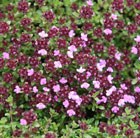 Thymus ‘Coccineus Group’ (thyme) £4.99 Position: full sun Soil: well-drained neutral to alkaline soil Rate of growth: average to fast Flowering period: June to July Flower colour: dark pink Other features: makes an excellent ground cover Hardiness: fully hardy Tiny, deep pink, tubular flowers appear in summer and are highly attractive to bees. This thyme is an excellent ground cover which forms a flat mat of glossy, blue-green leaves. Great for growing between paving where it will get light traffic that will release its lovely scent whenever it is trodden on. Garden care: After flowering cut back hard using garden shears to retain a neat compact shape  Thymus serpyllum ‘Pink Chintz’ (thyme) £4.99 Position: full sun Soil: well-drained neutral to alkaline soil Rate of growth: average to fast Flowering period: June to July Flower colour: clear pink Other features: highly attractive to bees and other beneficial pollinating insects Hardiness: fully hardy This mat-forming thyme produces a mass of clear pink flowers in summer. It’s an ideal ground cover plant for a sunny border or rock garden. Useful for attracting bees and other beneficial pollinating insects into the garden, the aromatic grey-green leaves release a lovely scent whenever they are trodden on. Garden care: After flowering cut back hard using garden shears to retain a neat compact shape. Lift and divide large clumps in early spring.  Thymus ‘Bressingham’ (thyme) £4.99 Position: full sun Soil: well-drained neutral to alkaline soil Rate of growth: average to fast Flowering period: June to July Flower colour: clear pink Other features: highly attractive to bees and other beneficial pollinating insects Hardiness: fully hardy Clear pink summer flowers and fragrant grey-green, hairy leaves. This compact scented thyme is ideal for planting in a sunny part of the garden in the crevices between paving stones. It thrives in the alkaline soil conditions commonly found between stones, releasing a lovely scent whenever it is trodden on. Garden care: After flowering cut back hard using garden shears to retain a neat compact shape. Lift and divide large clumps in early spring. Goes well with: Salvia officinalis ‘Icterina’, Melissa officinalis, Thymus serphyllum, Petroselium crispum, Ocimum sativum, Mentha spicata 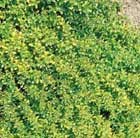 Thymus pulegioides ‘Aureus’ (golden-scented thyme) £6.99 Position: full sun Soil: well-drained neutral to alkaline soil Rate of growth: average to fast Flowering period: June to July Flower colour: lavender-pink Other features: the aromatic leaves are a useful ingredient in bouquet garni, stuffings and sauces; highly attractive to bees and other beneficial pollinating insects Hardiness: fully hardy Pale, lavender-pink summer flowers and luscious, lemon-scented grey- green leaves, tinged yellow. Lemon-scented thyme makes a lovely, summer flowering scented edge for a sunny herb garden. Perfect for planting in between paving stones, the aromatic leaves are an important ingredient in bouquet garni, stuffings and sauces. Garden care: After flowering cut back hard using garden shears to retain a neat compact shape. Lift and divide large clumps in early spring.  Thymus serpyllum ‘Pink Chintz’ (thyme) £3.99 Position: full sun Soil: well-drained neutral to alkaline soil Rate of growth: average to fast Flowering period: June to July Flower colour: clear pink Other features: highly attractive to bees and other beneficial pollinating insects Hardiness: fully hardy This mat-forming thyme produces a mass of clear pink flowers in summer. It’s an ideal ground cover plant for a sunny border or rock garden. Useful for attracting bees and other beneficial pollinating insects into the garden, the aromatic grey-green leaves release a lovely scent whenever they are trodden on. Garden care: After flowering cut back hard using garden shears to retain a neat compact shape. Lift and divide large clumps in early spring. 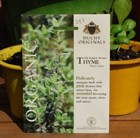 Thyme ‘Old English Winter’ (thyme – organic) £1.99 Position: full sun Soil: fertile, well drained and light Rate of growth: average Hardiness: hardy An aromatic, low growing herb, which is ideal for edging paths or filling pots on a sunny patio. The small pink flowers, which appear in summer, are very attractive bees and the scented foliage can be used fresh, dried or frozen to add flavour to a wide range of dishes. Keep well trimmed to allow new growth to come through. Growing Instructions: Sow in March to April, in pots or trays on the surface of barely moist seed compost and cover with a sprinkling of finely sieved compost. Place in a propagator at 15-20C until germination, which usually takes up to 24 days. Transplant the seedlings into small pots or cells until they are large enough to plant outdoors. Plant them 25cm apart in well prepared soil in full sun, after all risk of frost has passed, and they will be ready for harvest from July onwards. They are winter hardy, but for the best flavour, you should pick the new growth. Plants should survive for several years and they can be trimmed to keep their shape. Hebes at CrocusWednesday, July 18th, 2012 Hebes are beautiful plants! Add some colour to your garden. 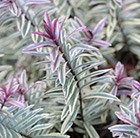 Hebe ‘Heartbreaker’ (Hebe) £12.99 Position: full sun or partial shade Soil: moist, well drained and fertile Flowering period: June – August Hardiness: frost hardy (will need protection in colder winters) Recently introduced to the commercial market, this is a wonderful, evergreen shrub that will put on a colourful display throughout the year. The slender, cream-edged, green leaves form neat mounds, and look very pretty throuhghout the spring and summer. When the temperatures drop they take on a vivid pink flush, which lasts until the spring. It is mainly grown for this decorative foliage, but in summer it also produces clusters of mauve-coloured flowers. Its compact, rounded habit makes it ideal for and ideal specimen for a pot, but it also looks sensational towards the front of the border. Garden care: Needs minimal pruning. Remove misplaced or frost damaged branches in late spring. Protect from severe winter weather. 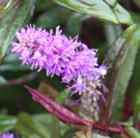 Hebe ‘Mrs Winder’ (veronica) £9.99 Position: full sun or partial shade Soil: poor or moderately fertile, moist, well-drained neutral to slightly alkaline soil Rate of growth: average Flowering period: August and September Flower colour: violet-blue Other features: dark green leaves, red-purple when young Hardiness: frost hardy In late summer, violet-blue flowers appear on purplish-brown shoots above the attractive foliage. The green leaves are tinged with red and purple when young, and have prominent, brown-purple midribs. This medium sized, rounded shrub is ideal for a well-drained border in sun or part shade. It’s particularly suitable for urban or coastal gardens since it tolerates urban pollution and salt-laden air. Garden care: Needs minimal pruning. Remove misplaced or frost damaged branches in late spring. 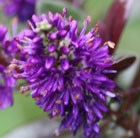 Hebe ‘Autumn Glory’ (hebe) £9.99 Position: full sun or partial shade Soil: poor or moderately fertile, moist, well-drained neutral to slightly alkaline soil Rate of growth: average Flowering period: July-October Hardiness: frost hardy (needs winter protection in cold areas) Deep purple flowers appear on short spikes from midsummer to late autumn, among masses of dark green, lance shaped leaves with red margins. Long- flowering, tough and easy to grow, this spreading, rounded, evergreen shrub will flourish in a wide range of conditions, and once established, is drought-tolerant, too. Plant it en masse along a fence or path, or to add structure to a mixed, sunny border, and underplant it with contrasting, drought-tolerant foliage plants such as Bergenia. The flowers are a magnet for bees and butterflies. Garden care: Needs minimal pruning. Remove misplaced or frost damaged branches in late spring. 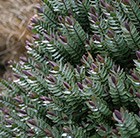 Hebe ‘Red Edge’ (shrubby veronica) £9.99 Position: full sun or partial shade Soil: poor or moderately fertile, moist, well-drained neutral to slightly alkaline soil Rate of growth: average Flowering period: June and July Hardiness: frost hardy (needs winter protection in cold areas ) Lilac-blue summer flowers appear on short spikes, fading to white, among grey-gr een leaves with narrow red margins and veining when young. This small, spreadin g, evergreen shrub makes an attractive low, informal hedge or edging plant for a mixed border. In an urban or coastal site, it needs protection from cold, dryi ng winds. Garden care: Needs minimal pruning. Remove misplaced or frost damaged branches in late spring. 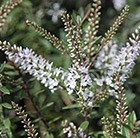 Hebe ‘Champagne’ (veronica) £8.99 Position: full sun or partial shade Soil: poor or moderately fertile, moist, well drained neutral to slightly alkaline soil Rate of growth: average Flowering period: July to September Hardiness: fully hardy Masses of lavender tinted, white flower spikes appear from summer to autumn on s lender purple stems. This tough, long-flowering, spreading shrub has slender, l ustrous, evergreen leaves and is an ideal low-maintenance choice for a border in sun or partial shade. In autumn and winter the foliage colour intensifies, and hues of deep plum emerge. It is salt and pollution tolerant and therefore suit able for city or coastal gardens. Garden care: Needs minimal pruning. Remove misplaced or frost damaged branches in late spring.  Hebe pinguifolia ‘Pagei’ (shrubby veronica) £8.99 Position:full sun or partial shade Soil:poor or moderately fertile, moist, well-drained neutral to slightly alkaline soil Rate of growth: average Flowering period: May and June Hardiness: fully hardy Masses of pure-white flowers on purple stems in late spring and early summer and fleshy, blue-green leaves. This neat, semi-prostrate evergreen shrub is an attractive groundcover plant for the front of a border in sun or part-shade and also looks good among silver-leaved plants. It is salt and poll ution tolerant and therefore suitable for city or coastal gardens. Garden care:Needs minimal pruning. Remove misplaced or frost damaged branches in late spring. 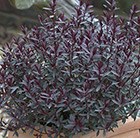 Hebe ‘Caledonia’ (shrubby veronica) £8.99 Position: full sun or partial shade Soil: poor or moderately fertile, moist, well-drained neutral to slightly alkaline soil Rate of growth: average Flowering period: June to October Flower colour: violet Other features: glossy, red-edged, dark green leaves Hardiness: fully hardy A compact form that makes an incredibly decorative and colourful conatiner or front of border plant. It is an evergreen shrub with glossy, red-edged, dark green leaves, which emerge with a vibrant plum flush in spring. They are held on upright reddish-purple stems that are topped with clusters of violet flowers from mid-summer to mid-autumn. This long-flowering plant is tolerant of pollution and salt-laden air. Garden care: Needs minimal pruning. Remove misplaced or frost damaged branches in late spring. 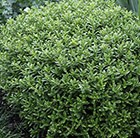 Hebe rakaiensis (shrubby veronica) £8.99 Position: full sun or partial shade Soil: poor or moderately fertile, moist, well-drained neutral to slightly alkaline soil Rate of growth: average Flowering period: June and July Hardiness: fully hardy One of the most popular hebes, this has clusters of large, white flowers in earl y and mid-summer and glossy, fresh, green leaves. This tough, rounded, evergreen shrub forms a neat hummock, and will lend structure to a mixed border or oriental-style garden. It is salt and pollution tolerant and is therefore suitable for city or coastal gardens. Garden care: Needs minimal pruning. Remove misplaced or frost damaged branches in late spring |